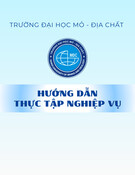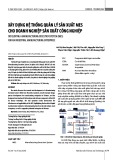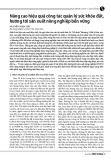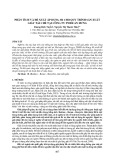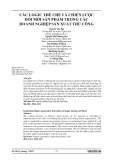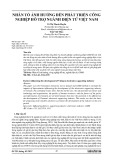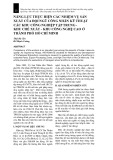
* Corresponding author Tel.: +966507022176
E-mail address: mabrouknejah@gmail.com (N. Ben Mabrouk)
© 2020 by the authors; licensee Growing Science.
doi: 10.5267/j.uscm.2020.2.006
Uncertain Supply Chain Management 8 (2020) ****–****
Contents lists available at GrowingScience
Uncertain Supply Chain Management
home
p
a
g
e: www.Growin
g
Science.com/usc
m
Factors influencing the performance of supply chain management in Saudi SMEs
Nejah Ben Mabrouka*, Anis Omrib and Bilel Jarrayac
aDepartment of Management Information Systems and Production Management, College of Business and Economics (CBE) - Qassim University,
P.O.Box: 6640, Buraidah 51452, Saudi Arabia
bDepartment of Business Administration, College of Business and Economics, Qassim University, P.O.Box: 6640, Buraidah 51452, Saudi Arabia
cDepartment of Accounting, College of Business and Economics, Qassim University, P.O.Box: 6640, Buraidah 51452, Saudi Arabia
C H R O N I C L E A B S T R A C T
Article history:
Received November 29, 2019
Received in revised format
February 20, 2020
Accepted February 22 2020
Available online
February 22 2020
The aim of this paper is to provide a practical approach by using an interpretive structural
modeling (ISM) approach to prioritize the most critical success factors that influence the
supply chain output in small and medium enterprises (SMEs). The analysis of MICMAC was
also considered for the identification of factors having a high power of influence. The findings
show that the most significant factors with the highest driving power are associated with
innovation and communication tools. Such findings can assist policy makers, administrators,
and practitioners in formulating supply chain effectiveness strategies and policies.
.2020 b
y
the authors; license Growin
g
Science, Canada©
Keywords:
Supply Chain Management
Performance
Critical factors
Interpretive structural
modeling (ISM)
SMEs
1. Introduction
Supply Chain Management (SCM) efficiency is considered a critical field of operations management
study. SCM comprises numerous interlinked resources and activities, beginning with the collection of
raw materials from the sources needed to create products and services for customers (Cooper et al.,
1997). SCM's main focus is on providing the right product to the consumers at the right cost, the right
time, the right quality and the right amount. While, SCM's short-term strategic objective is to minimize
cycle time and inventory and thus increase productivity, but the long-term objective is to increase
profits through market share and customer service. The purpose of this study is to recognize, in a first
step, the main factors that may contribute to the success of the supply chain from the existing literature,
and in a second step, to construct a standardized model based on these different factors. In the context
of Saudi SMEs, the motivators or critical factors that influence the supply chain output are established.
In addition, we propose an ISM-based modeling framework to identify and summarize the relationship
between factors that define an issue or problem (Sage, 1977). SCM performance variables or factors
were identified through a detailed literature review; academic and industry expert views were also
required. ISM approach was used to display the interrelationship between the factors and to classify
their effect on SCM results.

2
The present work therefore aims to deal with the following research questions: What are the driving
factors or determinants of SCM performance? What is the interaction between the factors chosen?
What determinants or variables have the high power of influence?
The present study aims to achieve the following research objectives by answering the above-mentioned
research questions: First, to identify the critical factors that influence SCM. Then, to examine the
relationship between identified critical factors. Finally, the study aims to evaluate the strength of the
relationship between the factors influencing SCM performance and to identify significant factors. Our
research adds to the current SCM success literature by offering a detailed model that consists of 14
factors defined from consultations with the field experts. The rest of the paper is organized as follow:
A literature analysis on the success factors of SCM performance in the next section, followed by the
solution methodology (section 3). Then, the interpretations and findings of the study are presented in
section 4. Conclusions and further research directions are drawn in section 5.
2. Literature review on the success factors of SCM performance
To evaluate the performance of SCM, there are four factors need be considered: cost, quality, time, and
flexibility. There are many different factors (variables) that affect SCM and in our research, these
factors are classified in six-dimension: Environmental uncertainty (EU), Business Management (BM),
Information Technology (IT), Manufacturing (M), Supply Chain relationships (SCR), Customer
Satisfaction (CS), and SCM Performance (SCP).
3.1 Environmental uncertainty (EU)
(EU) refers to issues related to unpredicted change in environment variables and the degree of
instability in technology, customer needs and tastes, supplier and competitor (Oke et al., 2012; Tohidi
et al., 2012). To meet such unexpected changes, companies need to develop the ability to understand
and cope with environmental changes (Wang et al., 2011a). According to Chen et al. (2004), It has been
extensively approved that good supplier relationships can contribute positively and meaningfully to
firm success. At the same time, supplier incorporation in product production processes is challenged in
particular by procurement as a conduit between internal corporate clients and external suppliers (Florian
et al., 2014). EU is regarded as a major factor in executing strategic supply plans. Several empirical
studies show that some forms of uncertainties adversely affect the performance of the supply chain
(Odkhishig & Yoshiki, 2017, Chen & Paulraj, 2004, Kim & Chai, 2016, Shabnam et al., 2015). The
definition of sub-factors in relation to environmental uncertainty is based on analysis of literature, there
are three: Company environment (EU1), suppliers and competition (EU1) and uncertainty aspects from
overseas (EU3).
2.2. Business Management (BM)
Based to literature, three different sub-factors are described in the Business management area:
innovations, process strategy and marketing strategy. To achieve goals and objectives, BM consists on
planning, organization and control of all the concerned actors and activities in company (Wang et al.,
2011b). Companies use process techniques to boost their market and manufacturing efficiency (Kumar
& Mishra, 2017). Using the correct tools for the specific area of need is critical to obtain the perfections
desired (Thomas et al., 2008). The marketing decisions included products, promotion, and distribution
has a stronger contribution to the strategy field (Yang & Gabrielsson, 2017). Innovation was described
by Najafi-Tavani et al. (2018) as establishing a new service and method and the perception of the
product on the market. There are two dimensions of product innovation success according to Hamid
and Jabbari (2012), which are effectiveness and efficiency. Innovation in performance is representative
of the level of innovation, but creative efficiency means the effort to succeed. There are three sub-
factors corresponding to business management: Process strategy (BM1), Marketing strategy (BM2) and
innovation (BM3).

N. Ben Mabrouk /Uncertain Supply Chain Management 8 (2020)
3
2.3. Information Technology (IT)
In the SCM, communications and technology enable users to communicate with each other. In addition,
the use of IT helps producers, vendors, distributors, consumers and retailers minimize paperwork, time-
out and other unnecessary practices (Gunasekaran et al., 2017). The networking tools are primarily
used to promote data transfer and to communicate between business units, mainly EDI, and facilitate
the electronic transfer of funds. As Han et al. (2017) note, advances in information technology and their
use in the supply chain make communication tools easier for users. Two sub-factors are related to the
information technology: Communication (IT1) and tools planning tools (IT2).
2.4. Customer Satisfaction (CS)
The understanding of consumers is not always the same as that of the supplier. Customers want to
obtain greater value on-time delivery, at low cost and at confirmed delivery date (Jesús et al., 2017).
According to Xiao et al. (2010) and Wright (2013), at all times, retailers and manufacturers are looking
for a post-sales process that allows them to reach the goal of customer satisfaction. Customer is the
main and effective component in SCM. The important goal of the company to be successful in its field
is to provide better services to customers in a very effective way (Tan, 2002; Wang et al., 2018).
2.5. Supply chain relationship (SCR)
To achieve the objectives of the company, the SCR depends on the synchronization and incorporation
between suppliers and understands the needs of customers that bring great benefits to companies. SCM
is directly interconnected to Relationship Management (Fynes et al., 2008; Artur et al., 2014), which
includes customers and suppliers. Strategic coordination between customers and suppliers is also a key
management practice in SCM (Carvalho et al., 2010; Flynn et al., 2010; Oosterhuis et al., 2013),
resulting the exchange of information and experience. Relationship with suppliers (SCR1) and
relationship with customers (SCR2) are considered in this factor (Sáenz et al., 2018).
2.6. Manufacturing
Added value can be defined as adding production or service measures to a product that the customer
considers to increase its value. Customers usually would like to pay the exact cost they thought they
should pay, and an added value is obtained when they get some additional features in the product.
Dealing with added value is related to two important factors: flexibility and quality (Askariazad &
Wannous, 2009, Remigio et al. 2010). Flexibility is described as being able to interact and adapt quickly
to market fluctuations. Market efficiency is measured by the extent to which a company can adapt and
handle unexpected situations (Kurien & Qureshi, 2015). The effect of flexibility on SCM performance
is discussed by many studies. (e.g. Aprile et al., 2005, 2006; Shibin et al., 2016; Seebacher & Winkler,
2015). Quality is the degree to which the goods meet the requirements of the customer, which is not
only a reward for the customer but is also an important factor to sell the product. Poor quality means
low level productivity, amplified costs and market share loss while the use of quality measures is used
to measure the feasibility of the production system (Kumar & Mishra, 2017). Three sub-factors are
considered in manufacturing: Flexibility (M1), production system (M2) and quality (M3)
3. Research Methodology
3.1. ISM approach
ISM is an innovative approach, focused on business and academic expert assessments. ISM may be
used to assess the contextual relationship between the different specifically defined factors of a problem
or situation (Warfield, 1974). ISM is used in several applications in the SCM context: Risk in SCM
(Mohamed, 2007; Faisal, 2006), vendor management (Anukul & Deshmukh, 1994; Thakkar et al.,
2010), reverse Supply chain (Govindan et al., 2012, Jayant & Azhar, 2014; Lim et al., 2017), green
supply chain (Jayant & Azhar, 2014; Malviya & Kant, 2017; Gardas et al., 2019a,b), sustainable supply
chain (Kumar & Rahman, 2017; Movahedipour et al., 2017; Rakesh et al., 2017; Bhaskar et al., 2019).
Fig. 1 outlines the detailed steps of the research methodology.

4
Fig. 1. Flow diagram of research methodology steps
3.2. ISM Model Development
3.2.1. Identification of Critical Factors Influencing the SCM Performance
Variables influencing the process are established through careful analysis of the literature and expert
opinions on the case field. The ISM model suggests making use of the opinions of experts to define the
conceptual relationship between selected variables. Participating in this study includes 50 experts or
managers with extensive experience in SCM from various fields. Of these, 38 full replied
questionnaires were completed (76%). A pair-wise analysis of the 14 variables set out above (Table 1)
by using of 5-pointer scale in which 5 is “Highly Influential”, 4 represents “Influential”, 3 represents
“Neither influential Nor Important”, 2 represents “Less Influential” and 1 represents “Not at all
Influential”.
Table 1
Critical Factors Influencing the SCM Performance
Factors References
Environmental uncertainty (EU)
Company environment (EU1)
Suppliers and competition (EU2)
Uncertainty aspects from overseas (EU3)
Wang et al. (2011), Oke et al. (2012), (Florian et al. 2014),
(Odkhishig & Yoshiki, 2017), Chen and Paulraj (2004), Kim and
Chai (2016), Shabnam et al. (2015)
Business Management (BM)
Process strategy (BM1)
Marketing strategy (BM2)
Innovation (BM3)
Chang et al. (2018), Wang et al. (2011, (Thomas et al., 2008),
(Yang and Gabrielsson,2017), (Hamid and Jabbari, 2012),
(Najafi-Tavani et al., 2018)
Information technology (IT)
Communication tools (IT1)
Planning tools (IT2)
Gunasekaranet al. (2017), Dominguez et al. (2018), Singh et al.
(2012), Acar and Uzunlar (2014),
Manufacturing
Flexibility (M1)
Production system (M2)
Quality (M3)
Askariazad and Wannous (2009), Remigio et al. (2010), Kurien
and Qureshi (2015), Aprile et al. (2005, 2006), Shibin et al.
(2016), Seebacher and Winkler (2015)
Supply chain relationship (SCR)
Relationship with suppliers (SCR1)
Relationship with customers (SCR2)
Fynes et al., (2008), Su et al. (2008), Artur et al. (2014 ),
Customer satisfaction (CS) Jesús et al., (2017), Xiao et al., (2010), Wright (2013), Tan,
(2002), Wang et al. (2018), Oosterhuis et al. (2013)

N. Ben Mabrouk /Uncertain Supply Chain Management 8 (2020)
5
The reliability of measures was validated using Cronbach's alpha coefficients on the responses from
experts. Acceptable reliability level requires coefficients from 0.7 (Hair et al., 2011). To aggregate the
answers of the experts used a threshold of 50%. If more than 50% answered “Highly Influential” or
“Influential”, we considered factor i contributes to factor j or factor j to i. Otherwise, i and j are
considered unrelated.
3.2.2. Development of SSIM
The SSIM (Table 2) is constructed from the feed-back of the expert opinions. The relationships between
two factors i and j is represented by the following notations:
i/j – Where i influences j but j has no effect on i;
j/i – when i does not lead to j and j does lead to i;
ij – factors i and j will help to achieve each other; and
NR – any relation of factors i and j.
3.2.3. Reachability Matrix (IRM)
The IRM is produced from the SSIM as shown in Table 3, making use of the following rules: If the (i,
j) cell is i/j, replace then by 1 and (j, i) entry by 0. If the (i, j) cell is j/i, replace then by 0 and (j, i) entry
by 1. If the (i, j) entry is ij, replace then by 1 and (j, i) by 1. If the (i, j) entry is NR, replace then by 0
and (j, i) by 0. The FRM (Table 4) is derived from the IRM, taking into account transitivity rules. The
transitivity principle is based on the following: if variable x is related to y and y is linked to z, then x is
necessarily related to z. In fact, any transitive connections between different variables should be
explored (Sushil, 2017).
Table 2
SSIM Matrix of the Critical Factors of SCM Performance
No. Factors 1 2 3 4 5 6 7 8 9 10 11 12 13 14 15
1 (EU1) ij i/j ij i/j i/j NR i/j i/j i/j NR NR i/j i/j NR i/j
2 (EU2) ij ij i/j i/j NR NR NR i/j NR NR i/j i/j NR i/j
3 (EU3) ij i/j i/j NR j/i NR i/j NR NR i/j i/j NR i/j
4 (BM1) ij i/j j/i j/i i/j i/j i/j NR NR NR NR i/j
5 (BM2) ij j/i j/i NR j/i NR j/i j/i j/i ij i/j
6 (BM3) ij i/j i/j i/j i/j i/j NR NR i/j i/j
7 (IT1) ij ij i/j NR i/j i/j i/j NR i/j
8 (IT2) ij i/j i/j i/j NR NR NR i/j
9 (M1) ij ij i/j NR i/j i/j i/j
10 (M2) ij i/j NR NR i/j i/j
11 (M3) ij i/j i/j i/j i/j
12 (SCR1) ij ij NR i/j
13 (SCR2) ij ij i/j
14 (CS) ij i/j
15 SCMP ij
Table 3
Initial Reachability Matrix (IRM)
No. 1 2 3 4 5 6 7 8 9 10 11 12 13 14 15
1 1 1 1 1 1 0 1 1 1 0 0 1 1 0 1
2 0 1 1 1 1 0 0 0 1 0 0 1 1 0 1
3 1 1 1 1 1 0 0 0 1 0 0 1 1 0 1
4 0 0 0 1 1 0 0 1 1 1 0 0 0 0 1
5 0 0 0 0 1 0 0 0 0 0 0 0 0 1 1
6 0 0 0 1 1 1 1 1 1 1 1 0 0 1 1
7 0 0 1 1 1 0 1 1 1 0 1 1 1 0 1
8 0 0 0 0 0 0 1 1 1 1 1 0 0 0 1
9 0 0 0 0 1 0 0 0 1 1 1 0 1 1 1
10 0 0 0 0 0 0 0 0 1 1 1 0 0 1 1
11 0 0 0 0 1 0 0 0 0 0 1 1 1 1 1
12 0 0 0 0 1 0 0 0 0 0 0 1 1 0 1
13 0 0 0 0 1 0 0 0 0 0 0 1 1 1 1
14 0 0 0 0 1 0 0 0 0 0 0 0 1 1 1
15 0 0 0 0 0 0 0 0 0 0 0 0 0 0 1


